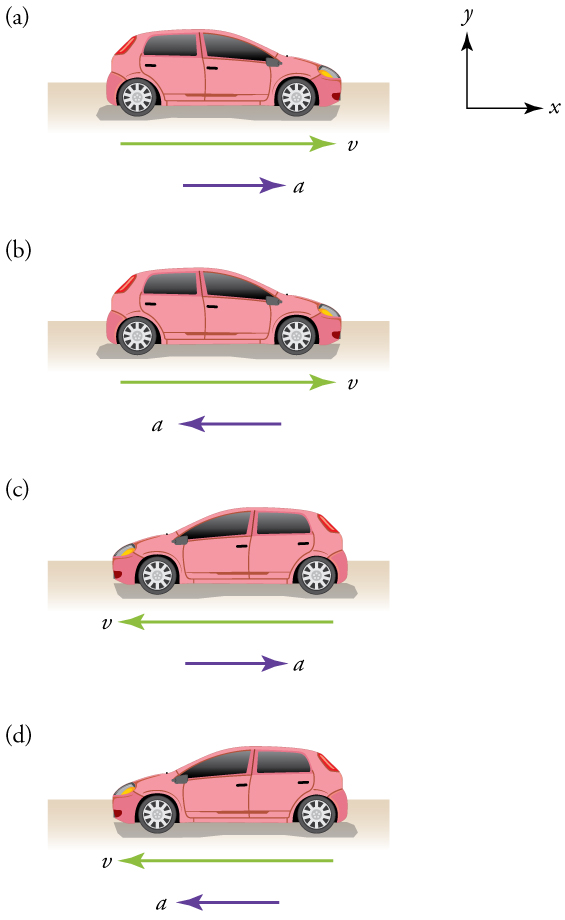[OpenStax College physics 2e: Kinematics] One-dimensional motion: Basic concepts
 Acceleration
Acceleration
In everyday conversation, to accelerate means to speed up. The accelerator in a car can in fact cause it to speed up. The greater the acceleration, the greater the change in velocity over a given time. The formal definition of acceleration is consistent with these notions, but more inclusive.
Average acceleration is the rate at which velocity changes,
\[ \begin{array}{rcl}\blue{\bar{a}}&=&\dfrac{\green{\Delta v}}{\orange{\Delta t}}&=&\dfrac{\green{{v}_{f}}-\green{{v}_{0}}}{\orange{{t}_{f}}-\orange{{t}_{0}}}\end{array}\]where #\blue{\bar{a}}# is average acceleration, #\green{v}# is velocity, and #\orange{t}# is time (the bar over the #\blue{a}# means average acceleration and recall that the subscripts #f# and #0# mean final and initial respectively).
Recall that velocity is a vector, i.e., it has both magnitude and direction. This means that a change in velocity can be a change in magnitude (or speed), but it can also be a change in direction. For example, if a car turns a corner at constant speed, it is accelerating because its direction is changing. The quicker you turn, the greater the acceleration. So there is an acceleration when velocity changes either in magnitude (an increase or decrease in speed) or in direction, or both.
Acceleration is a vector in the same direction as the change in velocity, #\green{\Delta v}#. Since velocity is a vector, it can change either in magnitude or in direction. Acceleration is therefore a change in either speed or direction, or both.
As with velocity, it is possible to take the time interval used to obtain the average acceleration to be infinitesimally small, thus obtaining the instantaneous acceleration. While such computations are outside the scope of this text, we will make use of the concept of instantaneous acceleration.
Instantaneous acceleration, #\blue{a}#, or the acceleration at a specific instant in time, is obtained by the same process as discussed for instantaneous velocity in Time, velocity, and speed; that is, by considering an infinitesimally small interval of time. How do we find instantaneous acceleration using only algebra? The answer is that we choose an average acceleration that is representative of the motion.
Let us look at an example of how to select an average acceleration from a graph of the instantaneous acceleration over time.
Figure 2 shows graphs of instantaneous acceleration versus time for two very different motions. In Figure 2 (a), the acceleration varies slightly and the average over the entire interval is nearly the same as the instantaneous acceleration at any time. In this case, we should treat this motion as if it had a constant acceleration equal to the average (in this case about #\blue{\unit{1.8}{m/s^2}}#). In Figure 2 (b), the acceleration varies drastically over time. In such situations it is best to consider smaller time intervals and choose an average acceleration for each. For example, we could consider motion over the time intervals from #\orange{0}# to #\orange{\unit{1.0}{s}}# and from #\orange{1.0}# to #\orange{\unit{3.0}{s}}# as separate motions with accelerations of #\blue{\unit{+3.0}{ m/s^2}}# and #\blue{\unit{–2.0}{ m/s^2}}#, respectively.
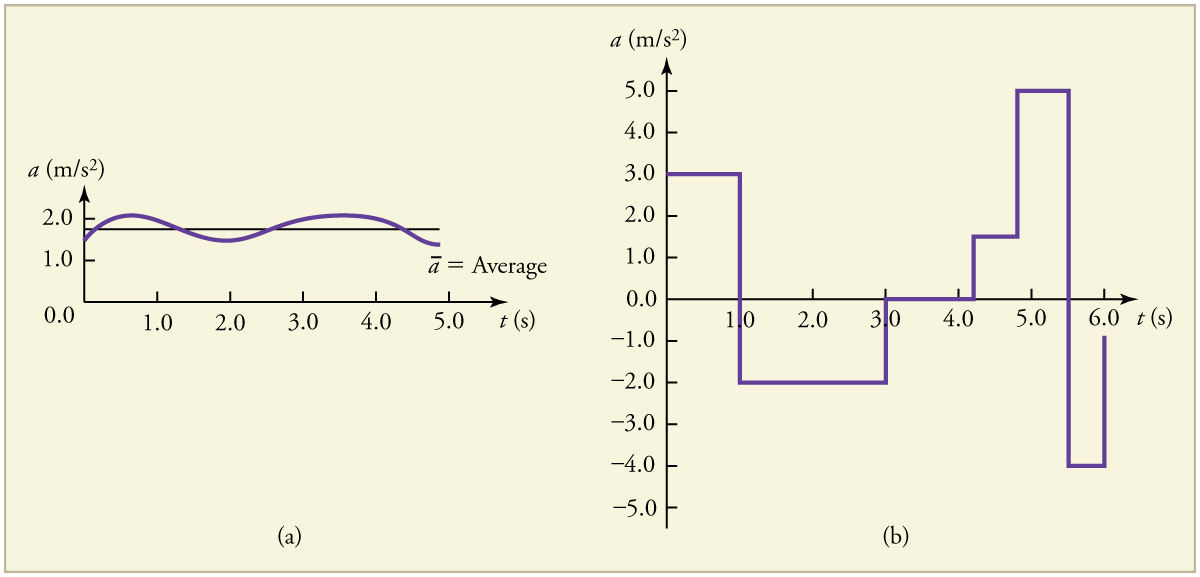
The next several examples consider the motion of the subway train shown in Figure 3. In (a) the shuttle moves to the right, and in (b) it moves to the left. The examples are designed to further illustrate aspects of motion and to illustrate some of the reasoning that goes into solving problems.
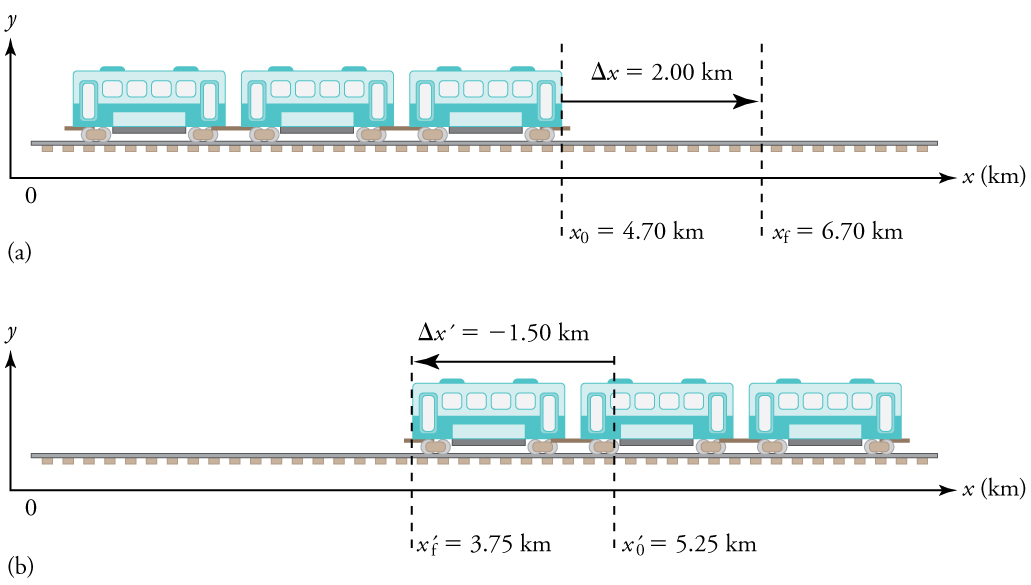
1. Outline a strategy
A drawing with a coordinate system is already provided, so we don’t need to make a sketch, but we should analyze it to make sure we understand what it is showing. Pay particular attention to the coordinate system. To find displacement, we use the equation #\Delta x={x}_{f}-{x}_{0}#. This is straightforward since the initial and final positions are given.
2. Solve for the displacement
- Identify the knowns. In the figure we see that #{x}_{f}=\unit{6.70}{km}# and #{x}_{0}=\unit{4.70}{km}# for part (a), and #{x'}_{f}=\unit{3.75}{ km}# and #{x'}_{0}=\unit{5.25}{km}# for part (b).
- Solve for displacement in part (a).
\[ \Delta x={x}_{f}-{x}_{0}=6.70-4.70=\unit{+2.00}{km} \] - Solve for displacement in part (b).
\[ \Delta x' ={x' }_{f}-{x'}_{0}=3.75 -5.25 = \unit{-1.50}{km}\]
Discussion
The direction of the motion in (a) is to the right and therefore its displacement has a positive sign, whereas motion in (b) is to the left and thus has a negative sign.
The graphs of position, velocity, and acceleration vs. time for the trains in the examples above and below are displayed in Figure 6 (we have taken the velocity to remain constant from #\orange{20}# to #\orange{\unit{40}{s}}#, after which the train decelerates).
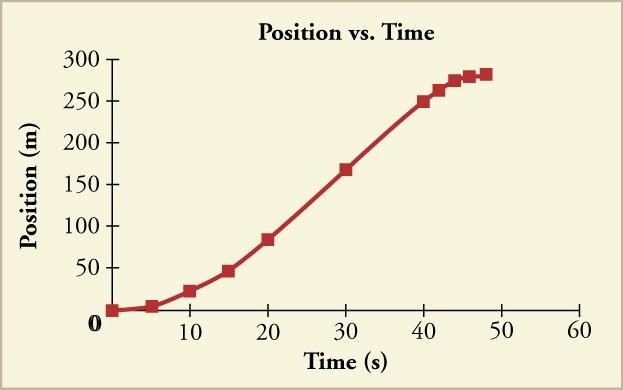
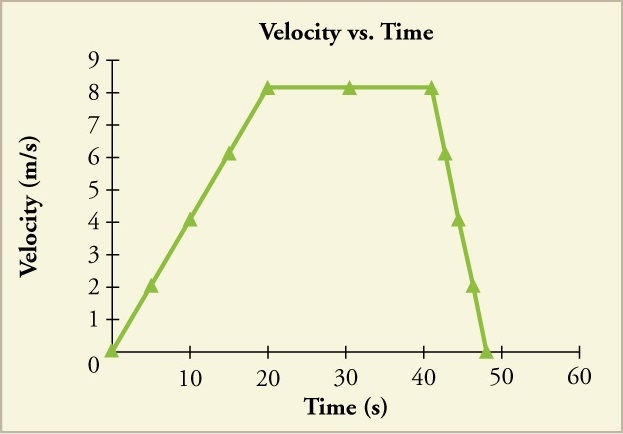
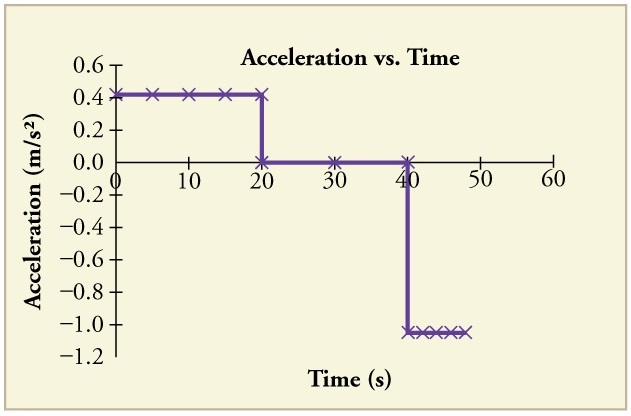
Calculating average velocity: the subway train
What is the average velocity of the train of Figure 3 (b), and shown again below, if it takes #\unit{5.00}{min}# to make its trip?

1. Outline a strategy
Average velocity is displacement divided by time. It will be negative here, since the train moves to the left and has a negative displacement.
2. Solve for the velocity
- Identify the knowns. #{x' }_{f}=\unit{3.75}{km}#, #{x'}_{0}=\unit{5.25}{km}#, #\Delta t=\unit{5.00}{min}#.
- Determine displacement, #\Delta x' #. We found #\Delta x' # to be #\unit{-1.5}{km}# in an example above.
- Solve for average velocity.
\[ \bar{v}=\dfrac{\Delta x' }{\Delta t}=\dfrac{\unit{-1.50}{km}}{\unit{5.00}{min}}\] - Convert units.
\[\bar{v}=\dfrac{\Delta x'}{\Delta t}=\left(\dfrac{\unit{-1.50}{km}}{\unit{5.00}{min}}\right)\left(\dfrac{\unit{60}{ min}}{\unit{1}{ h}}\right)=\unit{-18.0}{ km/h} \]
Discussion
The negative velocity indicates motion to the left.
Perhaps the most important thing to note about these examples is the signs of the answers. In our chosen coordinate system, plus means the quantity is to the right and minus means it is to the left. This is easy to imagine for displacement and velocity. But it is a little less obvious for acceleration. Let us discuss how this works for acceleration.
Most people interpret negative acceleration as the slowing of an object. This was not the case in the second example immediately above, where a positive acceleration slowed a negative velocity. The crucial distinction was that the acceleration was in the opposite direction from the velocity. In fact, a negative acceleration will increase a negative velocity. For example, the train moving to the left in the example above (Figure 7) is sped up by an acceleration to the left. In that case, both #\green{v}# and #\blue{a}# are negative. The plus and minus signs give the directions of the accelerations. If acceleration has the same sign as the velocity, the object is speeding up. If acceleration has the opposite sign as the velocity, the object is slowing down.

Or visit omptest.org if jou are taking an OMPT exam.


